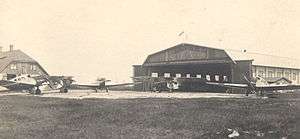Sablatnig P.III
| P.III | |
|---|---|
 | |
| Two P.III aircraft parked with Junkers F.13s at Lasnamäe Airfield, Estonia in 1925. | |
| Role | Airliner |
| National origin | Germany |
| Manufacturer | Sablatnig |
| Designer | Dr. Ing. Hans Seehase |
| First flight | 1919[1] |
| Introduction | 1921 |
| Retired | around 1930 |
| Number built | 30–40 |
The Sablatnig P.III was an airliner produced in Germany in the early 1920s.[2]
Development
A contemporary account identifies the P.III as Germany's first aircraft purposefully-designed as a commercial passenger plane.[1][3] It was a high-wing, strut-braced monoplane of conventional design powered by a single engine in the nose (either a 200-hp Benz, or a 260-hp Maybach).[3] Later the British 258-hp Armstrong Siddeley Puma engine was the usual power plant.[4][5] The crew of two, a pilot and a navigator or mechanic, were accommodated in separate open cockpits in tandem. These were behind the enclosed six seat passenger cabin in the center of the fuselage.[6] Passengers entered the cabin through a door directly from the ground, rather than having to climb over the side of the aircraft, or up a ladder. The P.III's cabin offered passengers the comfort of an expensive automobile.[1] The structure was of wood throughout, with the fuselage skinned in plywood.[7] The wings and horizontal stabiliser folded for storage or rail transport, and indeed, P.IIIs carried their own tent as a portable hangar.[1][8][9]
Operational history
This aircraft was one of the few approved as a civilian, not military type by the ILÜK (Interallierte Luftfahrt-Überwachungs-Kommission, Inter-allied Aviation Control Commission) for production in Germany after World War I.[10] However under the Treaty of Versailles all aircraft production was forbidden in Germany for a period of six months during the year 1920, and all existing aircraft, both military and civilian, and including aircraft built after the end of World War I, had to be either handed over to the Allied military or destroyed. As a result, Sablatnig ceased building aircraft. Apparently the existing P.IIIs were either hidden or smuggled out of Germany.
17 Sablatnig P.IIIs were registered in Germany in and after 1921. Fritz Sablatnig, the owner of the Sablatnig company, estimated total production at 30 to 40 examples, including 12 made in Estonia by Dwigatel.[11]
The P.III entered service with a number of airlines in Germany and other countries, including Lloyd Luftverkehr Sablatnig, Deutsche Luft Hansa, Danish Air Express, Aeronaut, as well as with the Swiss Air Force.[2]
Operators
- Danish Air Express
- Aeronaut
- Deutsche Luft-Reederei
- Deutscher Aero-Lloyd
- Deutsche Luft Hansa
- Lloyd Luftverkehr Sablatnig
Specifications
Data from The Sablatnig P.3 Monoplane", p.525
General characteristics
- Crew: Two, pilot and engineer
- Capacity: 6 passengers
- Length: 8.94 m (29 ft 4 in)
- Wingspan: 16.00 m (52 ft 6 in)
- Height: 3.25 m (310 ft 8 in)
- Wing area: 45.1 m2 (485 ft2)
- Empty weight: 1,400 kg (3,080 lb)
- Gross weight: 2,250 kg (4,950 lb)
- Powerplant: 1 × Maybach Mb IVa, 190 kW (260 hp)
Performance
- Maximum speed: 170 km/h (106 mph)
- Cruising speed: 150 km/h (93 mph)
- Stall speed: 80 km/h (50 mph)
- Range: 900 km (560 miles)
- Endurance: 6 hours
- Service ceiling: 3800 m (12500 ft)
- Rate of climb: 2.00 m/s ( ft/min)
See also
- Aircraft of comparable role, configuration and era
Notes
- 1 2 3 4 Wagner 1987 p. 258-259
- 1 2 Taylor 1989, p.787
- 1 2 "The Sablatnig P.3 Monoplane", p.521
- ↑ Wagner 1987 p. 259
- ↑ Great Britain. Parliament. House of Commons. Papers by Command, Volume 9. p. 21.
- ↑ "The Sablatnig P.3 Monoplane", p.525
- ↑ "The Sablatnig P.3 Monoplane", p.523–24
- ↑ "The Sablatnig P.3 Monoplane", p.524
- ↑ FLIGHT page 524
- ↑ Hirschel, Prem & Madelung 2004, p.56
- ↑ Wagner 1987 p. 262>
References
| Wikimedia Commons has media related to Sablatnig P.III. |
- Hirschel, Ernst-Heinrich; Horst Prem; Gero Madelung (2004). Aeronautical Research in Germany: From Lilienthal Until Today. Heidelberg: Springer.
- "The Sablatnig P.3 Monoplane". Flight: 521–25. 4 August 1921. Retrieved 2009-02-07.
- Taylor, Michael J. H. (1989). Jane's Encyclopedia of Aviation. London: Studio Editions.
- Wagner, Wolfgang (1987). Der Deutsche Luftverkehr – Die Pionierjahre 1919–1925. Koblenz: Bernhard und Graefe Verlag. ISBN 3-7637-5274-9.